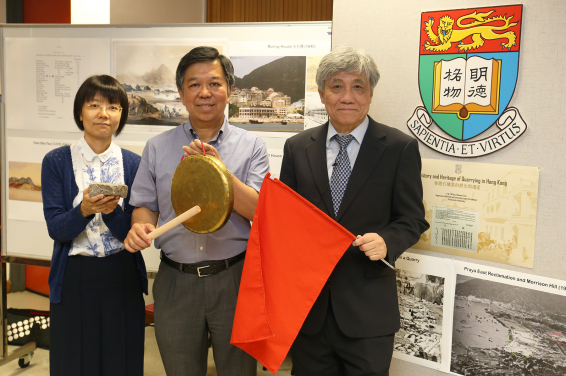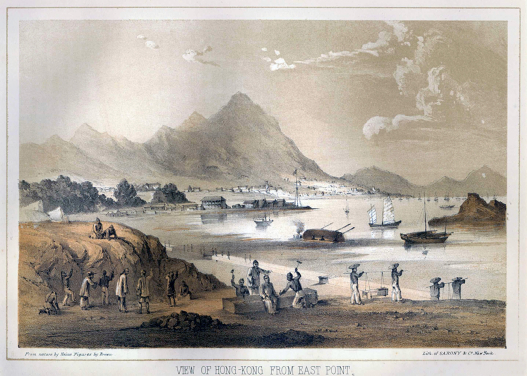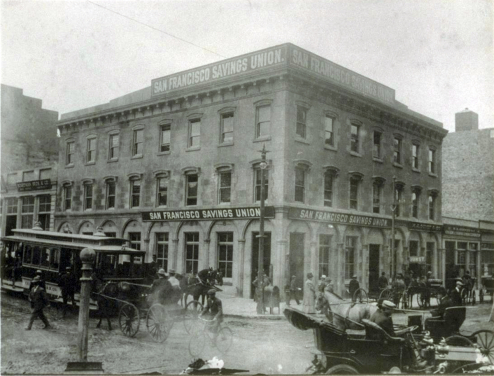Media
HKU Real Estate and Construction research team presents the “History and Heritage of Quarrying in Hong Kong” in its over 100 years of development
31 Jul 2018

Ir Dr Poon Sun Wah (right) and research team members Ir Man Ka Fai and Dr Deng Ying, holding a blast flag and gong used for warning before undergoing blasting work in quarries in old times.

A view from the far side of East Point (now Causeway Bay) across an area now the Victoria Park, of Chinese workers quarrying stone for building. The background is the Victoria Peak. (View of Hong Kong from East Point, 1856, by Heine, William. Source: Wattis Fine Art)
Murray House in different periods (Source of painting: 1846, painted by Murdoch Bruce, Historical Pictures, Collection of the Hong Kong Museum of Art)
Flagstaff House Museum of Tea Ware (Source of painting: 1846, painted by Murdoch Bruce, Historical Pictures, Collection of the Hong Kong Museum of Art)
- 1 / 7
- 2 / 7
- 3 / 7
- 4 / 7
- 5 / 7
- 6 / 7
- 7 / 7
Facing the problem of severe housing shortage, the Hong Kong government once again puts forth land reclamation as an option to increase land availability for housing development. Currently, over 90% of the fill material used for reclamation are imported. Yet, back in the old days, raw materials ranging from gravels for land reclamation to rock boulders for building breakwaters and raw construction materials were all supplied by local quarries.
Since the start of the Colonial Hong Kong era in 1842, the quarrying industry had become one of Hong Kong’s major economic pillar, bringing plentiful business and job opportunities. Of the over 7,400 residents on the Hong Kong Island in the early 1840s, about one-fourth were in quarrying related jobs. During the industry’s prime time in the early 20th century, there were over 100 quarries scattered in Hong Kong Island, Kowloon and the New Territories.
Hong Kong was once situated in an active volcanic zone. Frequent volcanic eruptions covered the city with volcanic and intrusive igneous rocks. In particular, the abundance of quality granitic rock provided valuable material for a number of early infrastructure constructions, including the Murray House (completed in 1845), the Museum of Tea Ware (completed in 1846, previously named as Flag Staff House), Central School (constructed from 1884 to 1889), The Bethanie (constructed from 1873 to 1875, now the Bethanie Campus of Hong Kong Academy for Performing Arts), former Marine Police Headquarters (completed in 1884, now renamed as “1881 Heritage”) and The Supreme Court of Hong Kong (completed in 1912, now the Court of Final Appeal). Walls, fences and old buildings constructed from granites are still visible everywhere these days.
Designer and constructor of Murray House, Major Aldrich and Lieutenant Collison of the Royal Engineers were responsible for the construction of a number of colonial military architecture. In 1846, Major Aldrich wrote about the construction of the Murray House in the Professional Papers of the Corp of Royal Engineers, sharing with engineers around the world how Chinese workers followed the principle of mechanics to transport large granite columns and cutting-edge architectural experience.
Back then, building materials and dimension stone from quarries were not only used to meet local demand but were also exported for construction in neighbouring regions and overseas. Granite used in building the French Catholic Church in Canton (construction began in 1863 and completed in 1888) was from the Ngau Tau Kok quarry and the Cha Kwo Ling quarry. In San Francisco, The Parrott Building (completed in 1852, demolished in 1926) was constructed using granite from Hong Kong and with the support of Hong Kong construction workers.
In fact, while the development of the quarrying industry in Hong Kong can be traced far back in history, evidenced by the use of granite to construct Song Wong Toi and a square well from the Sung Dynasty unearthed in 2014 on the construction site of Shatin-Central Line, the industry wasn’t structured until the call for reform by Sir John Francis Davis, the second Governor of Hong Kong.
He remarked that “In making the tour of this island by water with Rear Admiral Sir Thomas Cochrane, I observed a considerable number of stone quarries at work by the Chinese. These quarries have been accustomed to pay a duty to the Chinese Government and I have accordingly lost no time in giving due notice to the parties who work them that a duty will for the future be payable to the British Government.”
A series of reforms were launched including franchising the mining right of the whole Hong Kong Island to a single operator, and the introduction of a more structured tendering and leasing system later to incorporate a number of quarry operators in Hong Kong and Kowloon. In the New Territories, private-owned quarries were gradually acquired by the government for leasing.
A research team at the University of Hong Kong led by Dr SW Poon of the Department of Real Estate and Construction has devoted years of research to the construction history of Hong Kong lighthouses and the Tai Tam Reservoir (1883-1888). It is discovered that large-scale infrastructure and building developments throughout the history of Hong Kong were made possible largely due to the quarrying industry.
The research of “History and Heritage of Quarrying in Hong Kong” presents a general picture of the development of the quarrying industry and the infrastructure construction since 1841. An exhibition entitled "The Legend of Rocks: Destiny of Quarries" is now showing at the City Gallery in Central until September 10. Through presenting the ancient and modern settings of quarries in Hong Kong, the exhibition reviews the evolution of the quarry industry and showcases its contribution to the city's development.
Nowadays, the only quarry remaining in Hong Kong is the Lam Tei Quarry, meeting less than 10% of local demand. Looking ahead to the development needs of Hong Kong, the Government is interested in developing new quarries to supply local needs. The research team believes that environmental conservation should be fully considered in the planning stage and be included in the developmental blueprint with reference to foreign conservation experience.
For media enquiries, please contact Ms Melanie Wan, Communications and Public Affairs Office, tel: 2859 2600/ email: melwkwan@hku.hk.

